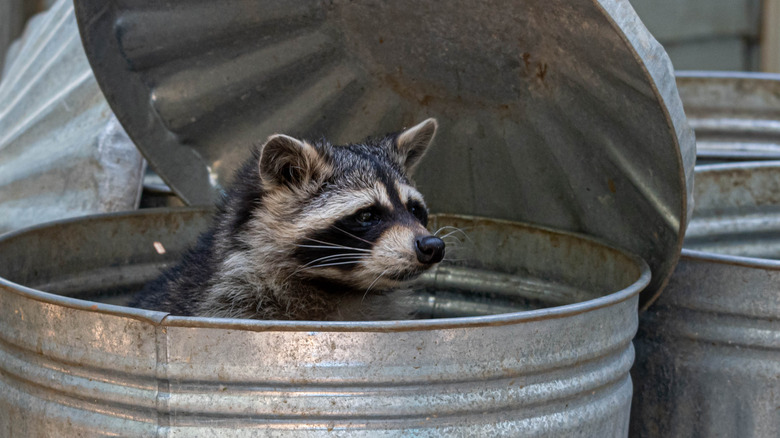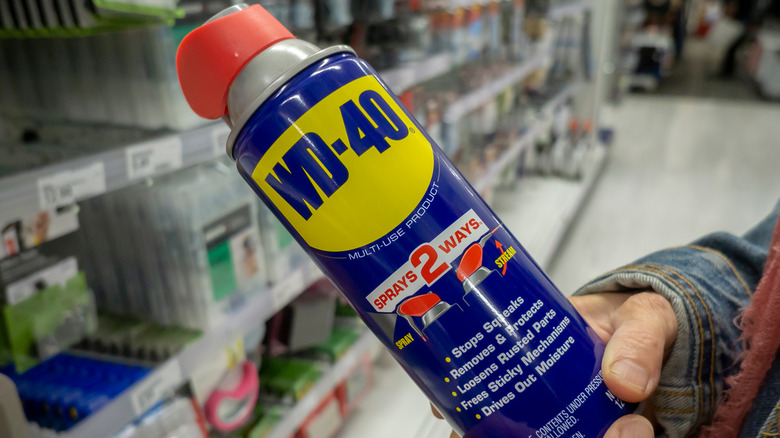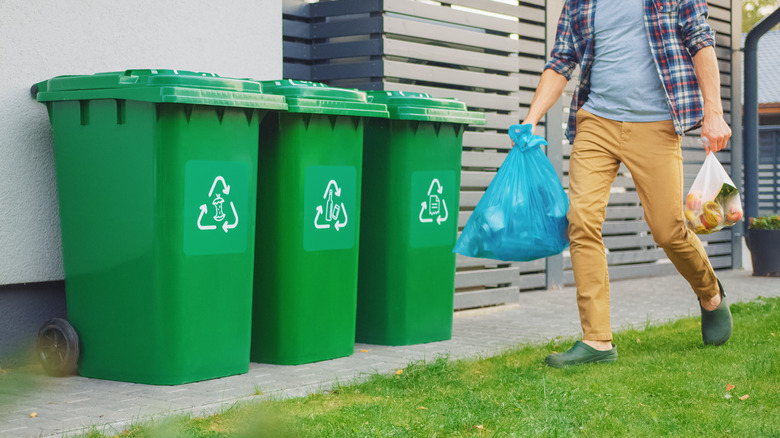The WD-40 Trick That Keeps Critters Out Of Your Trash Bins
We may receive a commission on purchases made from links.
Many homeowners and businesses face a perennial problem: critters rummaging through trash bins. Not only is it a nuisance to clean up and a jump scare waiting to happen, but it's also an unsightly image that no one wants to deal with first thing in the morning. Moreover, these invaders can often cause considerable damage to your trash cans and pose health hazards. Depending on your location, the culprits can range from the common raccoon to squirrels, rodents, and even larger animals.
Traditional methods like secure trash can lids, motion sensor lights, or traps often don't cut it, and the problem persists. However, there's a remarkably simple solution — in fact, it's a famously handy household item. WD-40. Yes, that's right. The same lubricant you use to stop squeaky hinges can help keep your trash bins critter-free. Here's how.
Before diving into the trick, it's worth understanding what WD-40 is. WD-40 is a water-displacing spray invented in 1953 by Norm Larsen, founder of the Rocket Chemical Company. Its name stands for "Water Displacement, 40th formula," indicating the number of attempts it took Larsen to perfect the product. Over time, WD-40 has evolved into a versatile tool used in various capacities, from loosening stuck parts to preventing rust, and now, as an unconventional remedy for our critter problem.
The slick WD-40 trick
The WD-40 trick involves spraying a light coating of the product on and around your trash bins. The magic behind the effectiveness of this trick lies in two properties of WD-40: its smell and slickness. Most animals, especially those known for rummaging through trash bins, have a highly developed sense of smell. The scent of WD-40 is strong and unfamiliar to them, and they tend to avoid it. This makes it a powerful deterrent. Additionally, WD-40 is a lubricant, which means it reduces friction. By spraying it on the exterior of your bins, you create a slick, slippery surface that most critters will find difficult to climb.
Before you begin, ensure that the trash bin is clean to maximize the effect of WD-40 and follow these simple steps. First, take your can of WD-40 and shake it well. Then, spray a thin coating around the outside of the bin, paying particular attention to the sides and lid to prevent climbing. Now, the easiest part, before you place any bags inside it or move the bin, enjoy a 15-minute break to let the WD-40 dry. That's it.
Just be sure to repeat this process and reapply after rain or every few days to maintain its effectiveness. A side note: if your trash can happens to be rusty, you best believe WD-40 will help with that too. Just spray a little more on those rusty areas and return in 10 to 15 minutes to brush off the rust. Replenish the area and any others to keep it pest free.
Things to consider when using WD-40
You can find just about anywhere if you don't already own WD-40. Try a local department store like Home Depot, a superstore like Walmart, and even Amazon. While the trick is generally safe, remember that WD-40 is a petroleum-based product. Please avoid spraying near open flames or high heat sources. This can cause severe damage to your property when left unattended and to yourself if you're not mindful of where it's being used. That's not all. Ensure you use WD-40 in a well-ventilated area to avoid inhaling excessive fumes. Outside is safe — however, it can be dangerous in a garage. Inhaling the fumes can cause nasal and respiratory irritations resulting in headaches, nausea, and vertigo.
The WD-40 trick is surprisingly simple, efficient, and cost-effective to keep critters away from your trash bins. Now, you don't have to worry about potential jump scares when taking out the garbage. This trick leverages a common household item's pungent scent and slickness to deter those dreadful guests from rummaging through your garbage. While WD-40 is not a 100% foolproof method, it significantly reduces the instances of critter visits, providing a practical solution for many. Remember, prevention is key when dealing with wildlife intrusions — maintaining clean, secured bins is your first line of defense.


